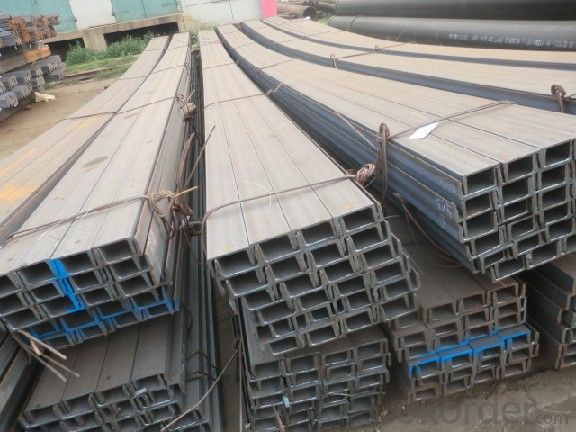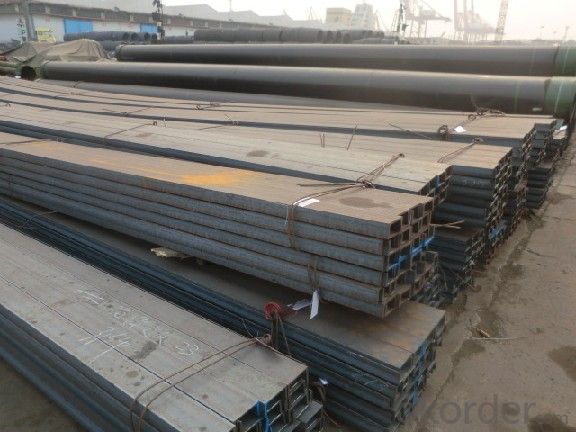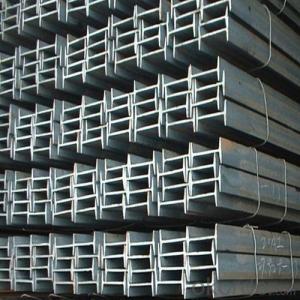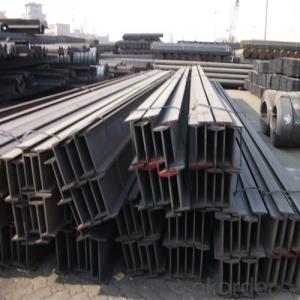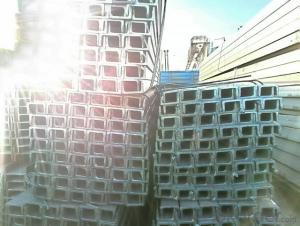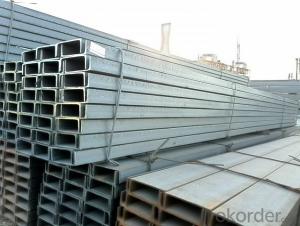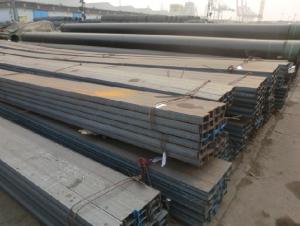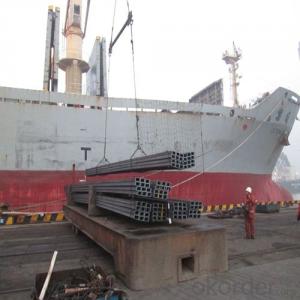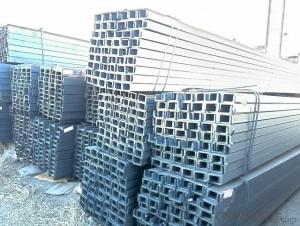JIS U-Channel Beams with Competitive Price
- Loading Port:
- Tianjin
- Payment Terms:
- TT OR LC
- Min Order Qty:
- 25 m.t.
- Supply Capability:
- 10000 m.t./month
OKorder Service Pledge
OKorder Financial Service
You Might Also Like
Product Description:
| Minimum Order Quantity: | 25MT | Unit: | m.t. | Loading Port: | Xingang Port |
| Supply Ability: | 120000TON/Year | Payment Terms: | TT or LC |
Product Applications:
Japanese Standard U-channels are ideal for structural applications and are widely used in the construction of buildings and bridges, and the manufacturing, petrochemical, and transportation industries.
Product Advantages:
OKorder's Japanese Standard U-channels are durable, strong, and resist corrosion.
Main Product Features:
· Premium quality
· Prompt delivery & seaworthy packing (30 days after receiving deposit)
· Corrosion resistance
· Can be recycled and reused
· Mill test certification
· Professional Service
· Competitive pricing
Product Specifications:
Manufacture: Hot rolled
Grade: Q195 – 235
Certificates: ISO, SGS, BV, CIQ
Length: 6m – 12m, as per customer request
Packaging: Export packing, nude packing, bundled
1. We are definitely speciallizing in manufacturing and supplying channel steel as per japanese standard, which is characterised with high mechanical strength and competitive prices.
Original Place | Tangshan, China | Brand Name | UINDA |
Standard | JIS G3192 : 1990 | ||
Material Grade | SS490 | ||
Sizes | 50mm to 200mm | ||
Sales Volume/Year | 3000MT | ||
Destination Area | Middle East, Africa, Southeast Asia | ||
2. The sections in details are as followings in the table-1
JIS U CHANNEL | Standard | Sectional | Dimension |
| Mass: |
| (mm) | (mm) | (mm) | (mm) |
|
50x25 | 50 | 25 | 3.0 | 6.00 | 2.37 |
75X40 | 75 | 40 | 3.8 | 7.00 | 5.30 |
75X40 | 75 | 40 | 4.0 | 7.00 | 5.60 |
75X40 | 75 | 40 | 4.5 | 7.00 | 5.85 |
75X40 | 75 | 40 | 5.0 | 7.00 | 6.92 |
|
|
|
|
|
|
100X50 | 100 | 50 | 3.8 | 6.00 | 7.30 |
100X50 | 100 | 50 | 4.2 | 6.00 | 8.03 |
100X50 | 100 | 50 | 4.5 | 7.50 | 8.97 |
100X50 | 100 | 50 | 5.0 | 7.50 | 9.36 |
|
|
|
|
|
|
125X65 | 125 | 65 | 5.2 | 6.80 | 11.66 |
125X65 | 125 | 65 | 5.3 | 6.80 | 12.17 |
125X65 | 125 | 65 | 5.5 | 8.00 | 12.91 |
125X65 | 125 | 65 | 6.0 | 8.00 | 13.40 |
|
|
|
|
|
|
150x75 | 150 | 75 | 5.5 | 7.30 | 14.66 |
150x75 | 150 | 75 | 5.7 | 10.00 | 16.71 |
150x75 | 150 | 75 | 6.0 | 10.00 | 17.90 |
150x75 | 150 | 75 | 6.5 | 10.00 | 18.60 |
150x75 | 150 | 75 | 6.5 | 10.00 | 24.00 |
|
|
|
|
|
|
200X80 | 200 | 80 | 7.5 | 11.00 | 24.60 |
Table-1
3. The mechanical property of JIS U Channel Steel in the table-2:
Grade | Yield Strength,N/mm² | Extension Strength N/mm² | |||
Thickness of Steel,mm | |||||
≦16 | >16-≦40 | >40-≦100 | >100 | ||
SS490 | ≧285 | ≧275 | ≧255 | ≧245 | 490-610 |
Table-2
4. The chemical composition of JIS U Channel Steel as per SS490 in the table-3
Grade | Element(%) | |||
C | Mn | P | S | |
SS490 | - | - | ≦0.050 | ≦0.050 |
Table-3
FAQ:
Q1: Why buy Materials & Equipment from OKorder.com?
A1: All products offered byOKorder.com are carefully selected from China's most reliable manufacturing enterprises. Through its ISO certifications, OKorder.com adheres to the highest standards and a commitment to supply chain safety and customer satisfaction.
Q2: How do we guarantee the quality of our products?
A2: We have established an advanced quality management system which conducts strict quality tests at every step, from raw materials to the final product. At the same time, we provide extensive follow-up service assurances as required.
Q3: The products are invoicing on theoritical weight or on actual weight?
A3: We can do it in both manners, according to the customers' request.
Images:

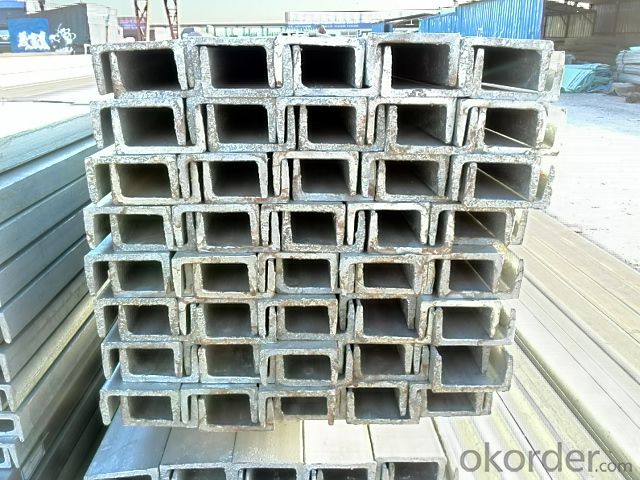
- Q: Are steel I-beams resistant to lightning strikes?
- Steel I-beams are not inherently resistant to lightning strikes. While steel is a good conductor of electricity, it does not guarantee protection against lightning strikes. Lightning is a powerful natural phenomenon that can strike anywhere, including structures made of steel. However, the risk of damage or fire caused by lightning can be mitigated by implementing proper lightning protection measures. These measures typically include lightning rods, grounding systems, and surge protectors that divert the electrical charge safely to the ground, minimizing the potential for harm. It is important to consult with a professional engineer or lightning protection specialist to ensure that adequate measures are in place to protect structures, including steel I-beams, from lightning strikes.
- Q: Are steel I-beams suitable for modular construction?
- Yes, steel I-beams are suitable for modular construction. Their structural properties make them an ideal choice for supporting heavy loads and spanning long distances in modular buildings. Steel I-beams have high strength-to-weight ratios, allowing for efficient use of materials without compromising structural integrity. They also provide excellent resistance to bending, which is crucial for ensuring the stability and longevity of modular structures. Additionally, steel I-beams are highly durable, fire-resistant, and can withstand extreme weather conditions, making them suitable for a variety of modular construction applications.
- Q: How do steel I-beams perform in high-temperature environments?
- Due to their inherent strength and heat resistance, steel I-beams are effective in high-temperature environments. With a high melting point, steel is capable of enduring elevated temperatures. The structural integrity and load-bearing capacity of steel I-beams remain largely intact in such environments. However, it is important to consider that the strength of steel decreases as the temperature increases. Beyond 500°C (932°F), the load-bearing capacity of the steel may begin to diminish. Furthermore, extended exposure to high heat can lead to deformation or warping of the steel, potentially compromising its structural integrity. Therefore, in extremely high-temperature environments, it may be necessary to implement additional fire protection measures such as fire-resistant coatings or insulation to ensure the optimal performance of the I-beams. In conclusion, steel I-beams are a dependable choice for use in high-temperature environments, but it is crucial to exercise caution in extreme conditions to guarantee their long-term effectiveness.
- Q: Can steel I-beams be used in elevated walkway construction?
- Yes, steel I-beams can be used in elevated walkway construction. Steel I-beams are commonly used in construction projects due to their strength, durability, and versatility. They provide excellent load-bearing capacity, making them suitable for supporting the weight of elevated walkways. Additionally, steel I-beams can be fabricated to various lengths and sizes, allowing for customized designs and efficient installation. The use of steel I-beams in elevated walkway construction ensures a stable and safe structure for pedestrians to walk on.
- Q: Can steel I-beams be used for support columns?
- Yes, steel I-beams can be used as support columns. They are commonly employed in construction projects as they provide excellent strength, stability, and load-bearing capacity, making them suitable for supporting heavy loads in structures such as buildings, bridges, and industrial facilities.
- Q: Are steel I-beams compatible with other building materials?
- Indeed, steel I-beams prove to be compatible with various building materials. Being a versatile construction material, steel commonly combines with other materials in construction projects. Easy integration is possible between steel I-beams and materials like concrete, wood, glass, and even other metals. These beams frequently function as load-bearing structural elements in buildings, providing support for other materials and enabling a wide range of design possibilities. Moreover, architects and engineers favor steel I-beams due to their flexibility and ease of customization according to specific project requirements. Consequently, steel I-beams represent a flexible and dependable option for construction projects, offering compatibility with diverse building materials.
- Q: What are the standard dimensions for steel I-beams?
- The standard dimensions for steel I-beams vary depending on the specific design and application. However, there are certain standard sizes that are commonly used in construction and engineering projects. The most common sizes for steel I-beams include: - Flange Width: Typically ranging from 2 to 14 inches, the flange width refers to the horizontal dimension of the I-beam's top and bottom sections. - Web Thickness: This refers to the vertical dimension of the I-beam's center section, which connects the top and bottom flanges. Web thicknesses typically range from 0.18 to 1.07 inches. - Flange Thickness: Ranging from 0.36 to 1.22 inches, the flange thickness refers to the thickness of the I-beam's top and bottom sections. These dimensions can vary depending on the load-bearing requirements and the specific structural application of the steel I-beam. It is crucial to consult the relevant engineering and construction standards, as well as structural engineers, for the appropriate sizing and design considerations for any specific project.
- Q: Can steel I-beams be used in educational or institutional building construction?
- Yes, steel I-beams can be used in educational or institutional building construction. Steel I-beams are commonly used in construction due to their strength, durability, and ability to support heavy loads. These beams provide structural support, allowing for larger open spaces and flexible design options in educational and institutional buildings. Additionally, steel is a sustainable and cost-effective material choice for construction projects.
- Q: Are there any alternatives to steel I-beams for structural support in construction?
- Yes, there are several alternatives to steel I-beams for structural support in construction. One alternative is the use of reinforced concrete beams. Reinforced concrete beams are made by embedding steel rebar within the concrete, providing both the compressive strength of concrete and the tensile strength of steel. This combination makes reinforced concrete beams highly durable and capable of withstanding heavy loads. Another alternative is the use of laminated timber beams, also known as glulam beams. Glulam beams are created by bonding together multiple layers of timber with adhesives, resulting in beams that are strong, lightweight, and aesthetically pleasing. Glulam beams offer a sustainable alternative to steel, as they are made from renewable resources and have a lower carbon footprint. Additionally, engineered wood products such as laminated veneer lumber (LVL) and parallel strand lumber (PSL) can be used as alternatives to steel I-beams. LVL is made by layering thin wood veneers and bonding them together with adhesives, creating a strong and dimensionally stable beam. PSL, on the other hand, is made by aligning wood strands and bonding them together, resulting in a beam with high strength and stiffness. Fiber-reinforced polymers (FRP) are also emerging as an alternative to steel I-beams. FRP composites consist of fibers embedded in a polymer matrix, such as carbon fiber reinforced polymer (CFRP) or glass fiber reinforced polymer (GFRP). These materials offer high strength-to-weight ratios, corrosion resistance, and excellent durability. However, they are still being researched and developed for widespread use in construction. Overall, while steel I-beams are commonly used for structural support in construction, there are several viable alternatives available, including reinforced concrete beams, laminated timber beams, engineered wood products, and fiber-reinforced polymers. The choice of alternative will depend on factors such as load requirements, design preferences, sustainability goals, and cost considerations.
- Q: The bridge pier cap beam on the I-beam have what use? What points should we pay attention to?
- General and combined with a hoop, construction measures, to provide a platform for coping construction. Attention, control the elevation, the size of I-beam should meet the load.
Send your message to us
JIS U-Channel Beams with Competitive Price
- Loading Port:
- Tianjin
- Payment Terms:
- TT OR LC
- Min Order Qty:
- 25 m.t.
- Supply Capability:
- 10000 m.t./month
OKorder Service Pledge
OKorder Financial Service
Similar products
Hot products
Hot Searches
Related keywords



